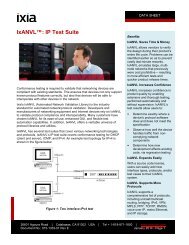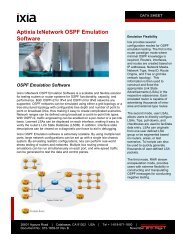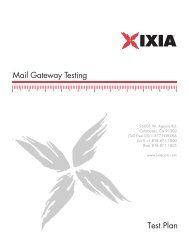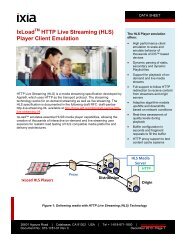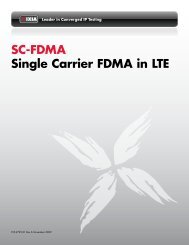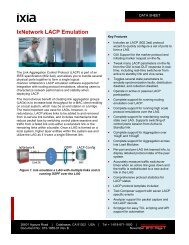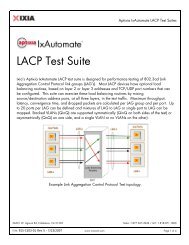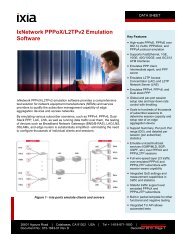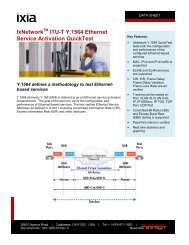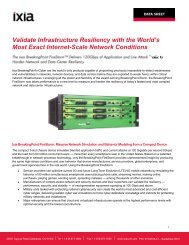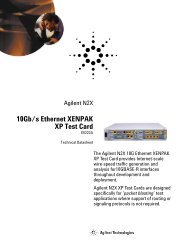BGP/L3VPN Conformance and Performance ... - Syrus Systems
BGP/L3VPN Conformance and Performance ... - Syrus Systems
BGP/L3VPN Conformance and Performance ... - Syrus Systems
You also want an ePaper? Increase the reach of your titles
YUMPU automatically turns print PDFs into web optimized ePapers that Google loves.
<strong>BGP</strong>/<strong>L3VPN</strong><strong>Conformance</strong> <strong>and</strong> <strong>Performance</strong> TestingSample Test Plans
<strong>BGP</strong> <strong>L3VPN</strong> <strong>Conformance</strong> <strong>and</strong> <strong>Performance</strong> Testing: Sample Test PlansOverviewThe <strong>L3VPN</strong> test plans presented hereinclude functional <strong>and</strong> performance testsdesigned for network <strong>and</strong> QA engineerstesting <strong>L3VPN</strong>/RFC 2547-enabled devices.RFC 2547 VPNs are a key application forMPLS technology <strong>and</strong> must be thoroughlyvalidated <strong>and</strong> tested against the device orsystem under test prior to deployment.These tests are intended as a baseline for<strong>L3VPN</strong> testing with further customization anatural step forward.1. VRF Isolation <strong>and</strong>Scalability TestObjectiveThis test verifies a DUT’s capabilities forVRF isolation with multiple CEs, each withsimilar prefix advertisements. The testutilizes an IGP advertising a fixed prefix foreach CE router. The device then forwardstraffic to <strong>and</strong> from a CE pair in the sameVRF. Verification includes countingreceived frames <strong>and</strong> ensuring that nocross talk has taken place. Scalability canthen be achieved by increasing thenumber of CEs.SetupA minimum of two network connections isrequired from the test tool to the DUT —one port will emulate multiple CEs witheach CE part of a different VRF. Thesecond port will match the first port byadvertising multiple CEs, each from adifferent VRF. The DUT is configured with atrunk 802.1q VLAN interface with aseparate VLAN for each VRF instance.IGP172.17.20.0/24Ixia emulated CEsVPN-AIXIAIxiaemulated CEsVPN-AIXIAIGP172.16.20.0/24IGP172.17.21.0/24VPN-BIXIAPEVPN-BIXIAIGP172.16.21.0/24IGP172.17.22.0/24VPN-CIXIADUTVPN-CIXIAIGP172.16.22.0/24IGP172.17.23.0/24VPN-DIXIAVPN-DIXIAIGP172.16.23.0/24number of CEsincreases s per iterationtraffic flowsroutes increaase bynumber of CEEs addedFigure 1. VRF isolation scalability test.<strong>BGP</strong>/<strong>L3VPN</strong> <strong>Conformance</strong> <strong>and</strong> <strong>Performance</strong> Testing: Sample Test Plans Copyright © Ixia, 2004 3
Input parametersTable 1.VRF isolation scalability test parameters.ParametersRoute Distinguisher(RD)Route Targets Import/ExportIGP/MPLS protocolDescriptionRoute Distinguishers are used primarily to distinguish routesespecially in overlapping VPN scenarios. The RouteDistinguisher is made up of two parts, the “Admin part” <strong>and</strong>“AS number”.Route targets are appended to prefixes to establish destinationVRFs <strong>and</strong> for import/export policies. This is applied to VPNprefixes to allow for import to other receiving VPN instances.IGP is the interior gateway protocol used to distribute theloopback address, <strong>and</strong> the MPLS protocol is used for signalingthe LSP to destination loopback.Methodology1. CE tester port 1 brings up an IGP orcustomer speaking protocoladvertising prefixes. The controlplane is established; a peer orneighbor is adjacent representing acustomer site or VPN acting CE.Figure 2 shows an exampleconfiguration of IGP <strong>and</strong> MPLSprotocol.2. CE tester port 2 is configured similarto step 1 with CE emulationadvertising a unique set of prefixesto the DUT.3. The tester sends traffic to each prefixadvertised in the VRF from eachemulated CE.4. Adding emulated CEs from the testtool protocol configuration scalesthis test. The configuration ismatched on the DUT. Pairs of CEs areadded to increase the VPN number<strong>and</strong> scale.5. Inject traffic flows to verify that eachroute is available as the test isscaled. Increase the number of CEsin the test until the desired size ofnetwork is successfully achieved.4 Copyright © Ixia, 2004 <strong>BGP</strong>/<strong>L3VPN</strong> <strong>Conformance</strong> <strong>and</strong> <strong>Performance</strong> Testing: Sample Test Plans
Figure 2. L3 VPN CE router wizard configuration.ResultsThe success of the result depends on thedesired size of the network. A positiveresult will be received flows for traffic atspecified rates or number of frames sent/received. Each CE should receive trafficbased on the prefix it advertises. This canbe done with verification of total framesreceived or a continuous rate test. Figure 3shows four CEs — two from one VRF, theother two from a separate VRF. Each pairof CEs advertise identical routes, but fromdifferent VPNs. The DUT in this case hastwo identical route prefixes but must keepthem separate. The graph in Figure 3shows consistency with frames sent <strong>and</strong>received. No one CE is receiving more thanits intended transmitter is sending it.<strong>BGP</strong>/<strong>L3VPN</strong> <strong>Conformance</strong> <strong>and</strong> <strong>Performance</strong> Testing: Sample Test Plans Copyright © Ixia, 2004 5
Frames sent <strong>and</strong> received are evenly distributed.No one CE is receiving more framesthan its intended transmitter is sending it.Figure 3. VRF isolation scalability test — results confirmation in graph.6 Copyright © Ixia, 2004 <strong>BGP</strong>/<strong>L3VPN</strong> <strong>Conformance</strong> <strong>and</strong> <strong>Performance</strong> Testing: Sample Test Plans
2. Route ReflectorPE Scalability TestObjectiveConfirm the number of configured PEs thata DUT can peer with <strong>and</strong> maintain theability to reflect routes.SetupThe test requires two tester ports — one totransmit traffic <strong>and</strong> one to receive. Thetransmit direction of traffic isunidirectional. Test port 2 is used toadvertise the PE route-reflector clients,while test port 1 sends traffic to verify theadvertised prefixes (Figure 4). During thetest, tester port 2 increases the number ofadvertised PEs each with new NLRI. Ixia’snew L3 VPN wizard utility in softwarerelease IxOS 3.80 can accomplish thissetup with minimal configuration steps.Routes can be verified with flows of trafficstreams from Ixia’s automated trafficgenerator utility.PE1routereflectorclientsIXIAprefix_1connect toroute reflectorclienttraffic reflected back to PEsPEroute reflectorrDUTconnect n toroute reflector e clientPE2PE3traffic flows to all other prefixesPE4IXIAIXIAIXIAprefix_2prefix_3prefix_4emulated PEssingle portIXIAPE0number of PEsincreases per iterationPE5IXIAprefix_5Figure 4. Route reflector PE scalability test topology.Input parametersTable 2.Route reflector PE scalability test parameters.ParameterRoute ReflectorTunnel EndpointDescriptionIf tested the DUT can be configured as reflector to all I<strong>BGP</strong> peers.Ultimate tunnel destination for peering session, usually the devicebeing tested loopback address.<strong>BGP</strong>/<strong>L3VPN</strong> <strong>Conformance</strong> <strong>and</strong> <strong>Performance</strong> Testing: Sample Test Plans Copyright © Ixia, 2004 7
Figure 5. <strong>L3VPN</strong> configuration wizard.Methodology1. Tester port 1 emulates a single PE<strong>and</strong> establishes a session with theDUT PE. This port is also used as thetraffic generator <strong>and</strong> for confirmingreflected routes.2. The second port will be an 802.1qtrunk with a separate VLAN-per-PErelationship. The control plane isestablished here, <strong>and</strong> the configurednumber of PEs is established, eachwith an L3 site. Each PE emulated bythe test tool is advertising a numberof prefixes to be reflected by the DUT.Figure 5 shows the Ixia wizardconfiguration for PE-specificparameters.3. The tester generates traffic streamssourced from tester port 1 with adestination of each PE’s advertisedprefixes on tester port 2.4. The number of PEs on tester port 2 isscaled <strong>and</strong> traffic flows re-run to allprefixes to include the additionalPEs’ route advertisements.8 Copyright © Ixia, 2004 <strong>BGP</strong>/<strong>L3VPN</strong> <strong>Conformance</strong> <strong>and</strong> <strong>Performance</strong> Testing: Sample Test Plans
ResultsA successful result during any giveniteration is confirmation of the routesreceived on the single PE tester port 1 forall reflected routes in the VPN. To furtherverify that the DUT is able to forward at agiven rate <strong>and</strong> to test the data plane, thereceived flows of traffic destined to eachPE’s prefix must be verified. Ixia’sIxExplorer Learned VPN Routes viewindicates the number of routes learned bytester port 1, <strong>and</strong> the IxExplorer Statistics<strong>and</strong> Latency views can be used to verifyper flow received statistics. Thisinformation is useful for determining theMPLS forwarding capability to each prefixregardless of PE. Statistics can be filteredby the destination MAC, providing anindividual PE received count.Figure 6. Route reflector PE scalability test — <strong>BGP</strong> routes received statistics.<strong>BGP</strong>/<strong>L3VPN</strong> <strong>Conformance</strong> <strong>and</strong> <strong>Performance</strong> Testing: Sample Test Plans Copyright © Ixia, 2004 9
Figure 7. Route reflector PE scalability test — frames received per emulated PE.10 Copyright © Ixia, 2004 <strong>BGP</strong>/<strong>L3VPN</strong> <strong>Conformance</strong> <strong>and</strong> <strong>Performance</strong> Testing: Sample Test Plans
3. Ingress/EgressForwarding<strong>Performance</strong> TestObjectiveDetermines the maximum rate at which aLabel Switched Router (LSR) configured asa L3 VPN Provider Edge (PE) node canstrip/pop or apply/push MPLS labels to<strong>and</strong> from incoming IP packets. Theresulting throughput of this operation isthen measured to the point of no loss.SetupThis test requires two ports; one tosimulate the PE router <strong>and</strong> another tosimulate the customer edge (CE) router.Ixia’s IxScriptMate application can be usedto execute this test.IP trafficMPLS trafficNW stubIXIACustomerEdge (CE)OSPFDUTProviderEdge (PE)OSPFLDPIXIAProviderCore (PC)IXIAProviderEdge (PE)MP-i<strong>BGP</strong> session overprovider backboneFigure 8. Ingress/egress forwarding performance test setup.Input parametersTable 3. Ingress/egress forwarding performance test input parameters.ParameterDescriptionOSPF Parameters Area ID <strong>and</strong> network type, Prefix/Mask information.<strong>BGP</strong> parameters AS number, Peer address, Prefix/Mask information.# Routes per CE Defined amount of routes for each CE to advertise.Traffic rateDesired rate to send traffic to be popped or pushed.<strong>BGP</strong>/<strong>L3VPN</strong> <strong>Conformance</strong> <strong>and</strong> <strong>Performance</strong> Testing: Sample Test Plans Copyright © Ixia, 2004 11
Figure 9. IxScriptmate ingress/egress forwarding performance test configuration.Methodology1. The port simulating the PE/P routerestablishes an IGP session with theDUT <strong>and</strong> advertises the loopbackaddress of the simulated PE router.Traffic engineering parameters areadvertised using OSPF-TE, IS-IS-TE,or LDP protocols.2. Bi-directional LSPs are establishedusing RSVP-TE or LDP.3. A multi-protocol internal <strong>BGP</strong> (MPi<strong>BGP</strong>)session is established with theDUT.4. The port simulating the PE routertransmits MPLS traffic at thespecified rate; if frame loss occurs,the transmission rate is alternatelyreduced/increased using a binarysearch algorithm to determine themaximum rate at which the DUT canforward traffic without loss.12 Copyright © Ixia, 2004 <strong>BGP</strong>/<strong>L3VPN</strong> <strong>Conformance</strong> <strong>and</strong> <strong>Performance</strong> Testing: Sample Test Plans
ResultsThe test results given by Ixia’s IxScriptmatewill reflect <strong>and</strong> produce successfultransmit rate, latency of the MPLS trafficpopped/pushed, data errors in payload,<strong>and</strong> sequence errors. Figure 10 showsexample test results.total frames transmitted <strong>and</strong> receivedFigure 10. IxScriptmate ingress/egress forwarding performance test results.<strong>BGP</strong>/<strong>L3VPN</strong> <strong>Conformance</strong> <strong>and</strong> <strong>Performance</strong> Testing: Sample Test Plans Copyright © Ixia, 2004 13
4. VPN Merging Test ObjectiveThis test determines a PE’s ability toimport different VPNs to a single VPN byrunning traffic flows <strong>and</strong> verifying receivedstatistics for each VRF instance.SetupThis test requires at least two tester ports.Tester port 1 acts as a CE for trafficgeneration to all VPN routes learned whiletester port 2 emulates a group of PErouters, each from a different VRF/VPNadvertising unique prefixes. The DUT PEreceives all routes <strong>and</strong> merges them intoone common VPN to distribute to testerport 1.AS 500VRFs are being imported<strong>and</strong> traffic verifiedby each PE receiving statsemulation porttest port 2PE1IXIAtraffic flowsVRF1VRF2IXIADUTPE2VRF3importVRF1, VRF2VRF3, VRF4VRF5, VRF6IXIAPE3VRF4VRF5external VRFsadvertising to the DUTIXIAtraffic flowsVRF6Figure 11. L3 VPN merging test topology.Input parametersTable 4. L3 VPN merging test parameters.ParameterPE configurationVRF configurationP router setupDescriptionNumber of PEs, loopback determination, route reflectoraddress configuration.Includes number of VRFs per PE, import/export definitions,<strong>and</strong> prefix advertisements.Defines the IGP <strong>and</strong> signal protocol used to build localadjacency <strong>and</strong> learn the outer MPLS label.14 Copyright © Ixia, 2004 <strong>BGP</strong>/<strong>L3VPN</strong> <strong>Conformance</strong> <strong>and</strong> <strong>Performance</strong> Testing: Sample Test Plans
Methodology1. Tester port 1 advertises a CE devicesending traffic to severaldestinations from the merged VPN.2. Tester port 2 advertises a configurednumber of PEs, each with a givenamount of VRF sites. These siteprefixes should be confirmed in theDUT’s forwarding table for each VRFinstance.3. The VRF instances are merged toone common VPN. This VPN is on thetester port 1 VRF, where traffic isbeing sent to each destination.Figure 12 shows Ixia VPN wizardconfiguration for VRF setup section.Each parameter is configured in thewizard setup pertaining to P, PE, <strong>and</strong>VRF specifics.4. Start traffic flows from the tester port1 port <strong>and</strong> confirm the delivery of theflows on a per PE or VRF basis.Figure 12. L3 VPN merging test VRF wizard configuration.<strong>BGP</strong>/<strong>L3VPN</strong> <strong>Conformance</strong> <strong>and</strong> <strong>Performance</strong> Testing: Sample Test Plans Copyright © Ixia, 2004 15
ResultsThe expected results of this test plan areconfirmation that the desired rates oftraffic being received on a per VRF basis.The results of this test can be viewed viathe IxExplorer GUI interface. Figure 13shows an example graph of received framerates for each VRF being emulated by theIxia protocol server. The correct result iseach VRF receiving the same amount oftotal frames during the test.frames received per VRFFigure 13. L3 VPN merging test results graph.16 Copyright © Ixia, 2004 <strong>BGP</strong>/<strong>L3VPN</strong> <strong>Conformance</strong> <strong>and</strong> <strong>Performance</strong> Testing: Sample Test Plans



